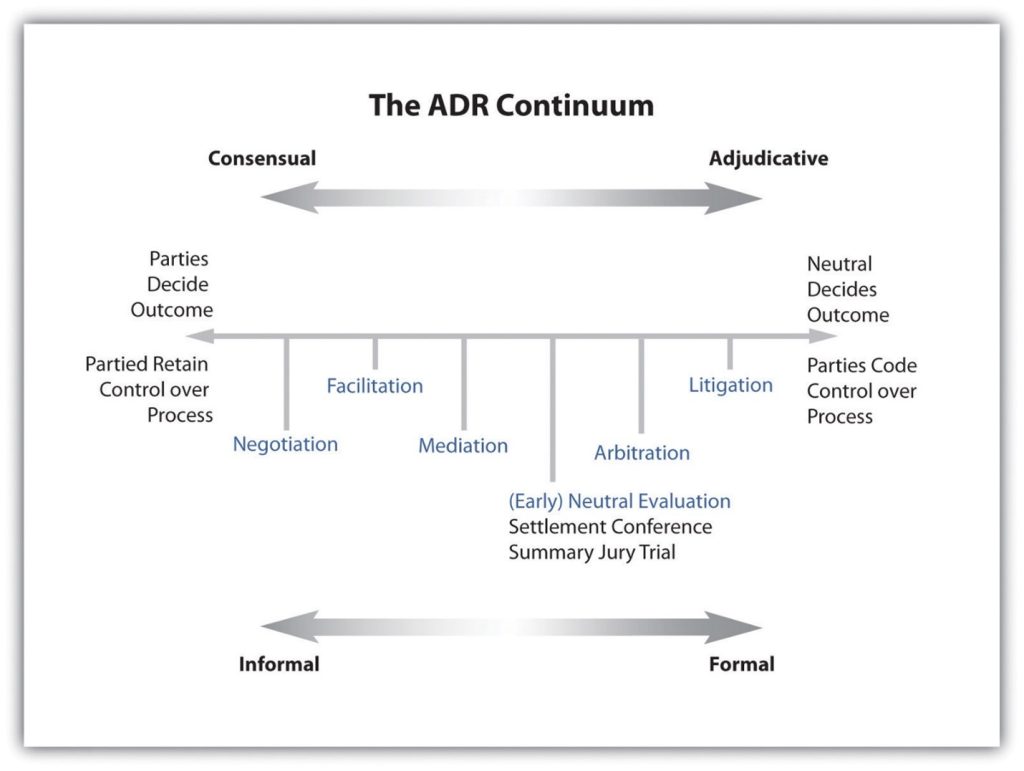A.1.3 Benefits and Drawbacks of Alternative Dispute Resolution
Learning Objectives
3: Understand the benefits and drawbacks of alternative dispute resolution.
Imagine that you’ve been wronged by a supplier, by your employer, or by a business where you are a customer. You’ve correctly determined that you have an actionable legal claim. What are you going to do? You probably won’t run to the courthouse to file a formal complaint to initiate litigation. This is because litigation is very expensive and time-consuming. Besides, you may wish to continue doing business with the supplier, employer, or business. Perhaps the matter is of a private nature, and you do not want to engage in a public process to determine the outcome. You would like the dispute to be resolved, but you do not want to engage in public, time-consuming, expensive litigation to do it.
A common method of dispute resolution that avoids many of the challenges associated with litigation is alternative dispute resolution. Alternative dispute resolution (ADR) is a term that encompasses many different methods of dispute resolution other than litigation. ADR involves resolving disputes outside of the judicial process, though the judiciary can require parties to participate in specific types of ADR, such as arbitration, for some types of conflicts. Moreover, some ADR methods vest power to resolve the dispute in a neutral party, while other strategies vest that power in the parties themselves. See Figure 1.3, “A Continuum of Different ADR Methods,” for a continuum of different ADR methods based on where the power to solve the dispute is vested.

Image Description
The ADR Continuum depicts a spectrum of Alternative Dispute Resolution (ADR) methods. The continuum is represented by a horizontal arrow that ranges from “Consensual” on the left to “Adjudicative” on the right.
Left Side (Consensual):
- Characteristics: Parties decide the outcome, and parties retain control over the process.
- Methods listed: Negotiation, Facilitation, Mediation
Right Side (Adjudicative):
- Characteristics: A neutral party decides the outcome and parties cede control over the process.
- Methods listed: (Early) Neutral Evaluation, Arbitration, Litigation
Middle Section:
Contains a series of vertical lines below the horizontal arrow that correspond to different ADR methods, moving from more informal to more formal as you move rightward:
Informal on the left (closer to Consensual):
- Negotiation
- Facilitation
- Mediation
Neutral in the middle:
- (Early) Neutral Evaluation: Settlement Conference and Summary Jury Trial
Formal on the right (closer to Adjudicative):
- Arbitration
- Litigation
This continuum helps to illustrate the varying degrees of formality, party control, and decision-making authority associated with different ADR methods.
Common methods of ADR include negotiation, mediation, and arbitration. Lesser used methods of ADR, which include minitrials, hybrid forms of mediation-arbitration (with elements of both), and collaborative goal-oriented processes. ADR often resolves disputes among businesses, employers and employees, and businesses and consumers. ADR can also be used in many other types of conflicts. For instance, ADR strategies can be used in domestic law cases, such as divorce, or in international legal issues, such as issues relating to transboundary pollution.
“4.4 Other Methods of Alternative Dispute Resolution” from The Legal and Ethical Environment of Business v. 1.0 by Saylor Academy is licensed under a Creative Commons Attribution-NonCommercial-ShareAlike 3.0 License, except where otherwise noted.

